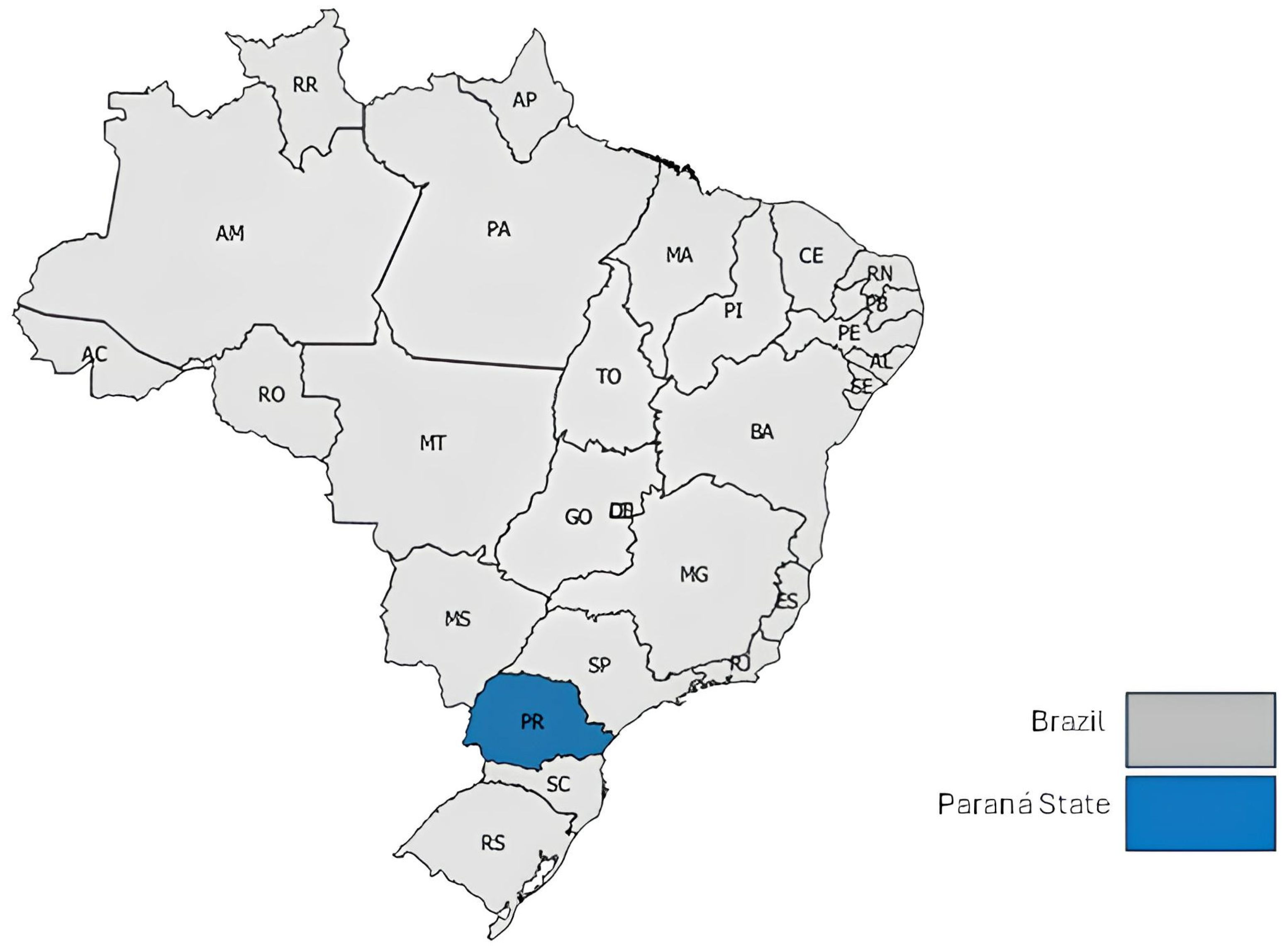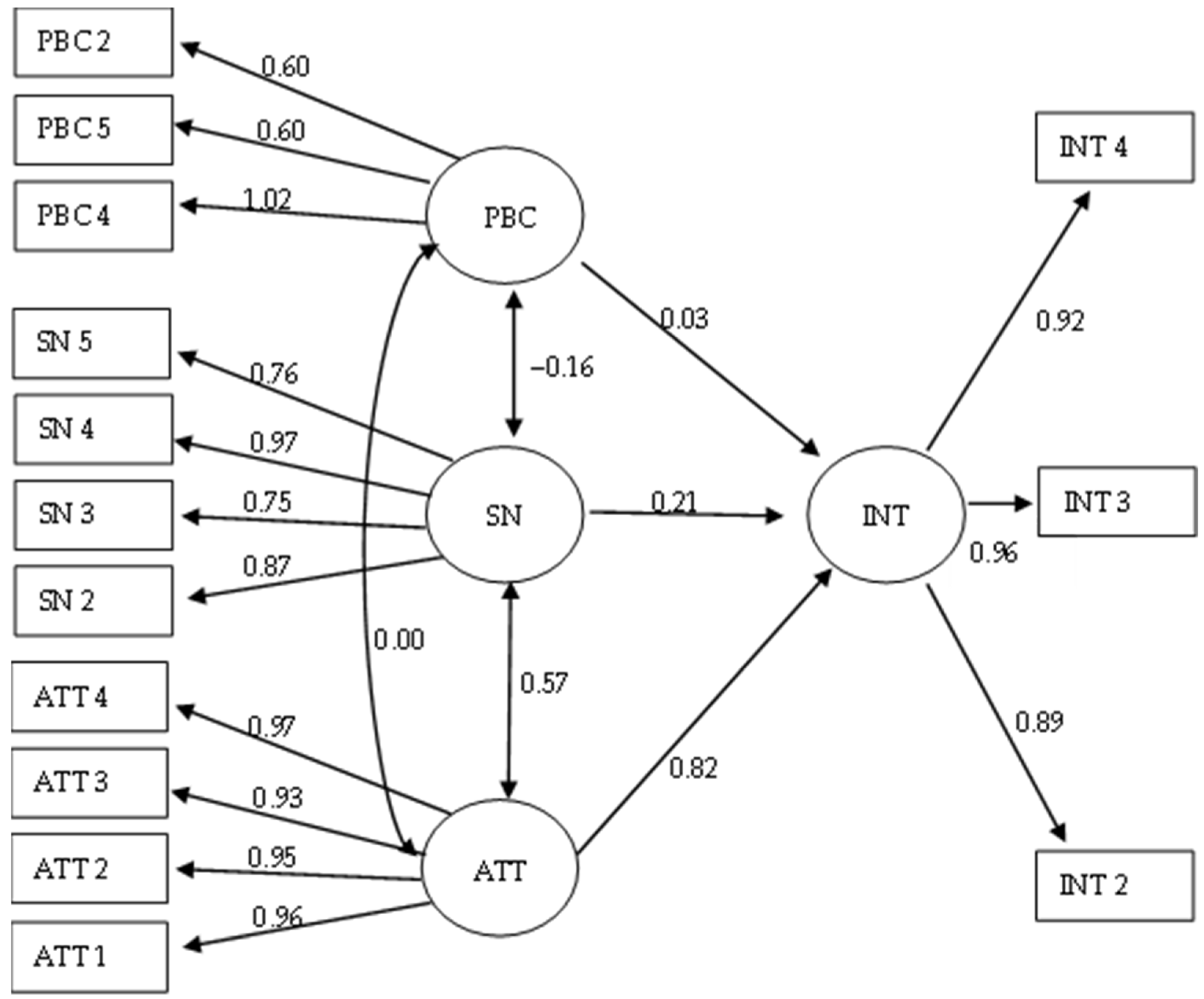Influence of Psychological Factors on Dairy Farmers’ Intentions to Adopt Environmental Sustainability Practices in Paraná State, Brazil
Abstract
1. Introduction
2. Materials and Methods
2.1. Study Site
2.2. Data Collection
2.3. Data Analysis
3. Results
3.1. Socioeconomic and Production Characteristics
3.2. Measurement Model
3.3. Structural Model
3.4. Data Analysis
4. Discussion
4.1. Production and Socioeconomic Characteristics
4.2. Correlation between INT and Socioeconomic and Production Characteristics
4.3. Farmers’ Intentions to Adopt Sustainability Practices in Dairy Production
4.4. Study Limitations
5. Conclusions
Author Contributions
Funding
Institutional Review Board Statement
Informed Consent Statement
Data Availability Statement
Acknowledgments
Conflicts of Interest
References
- Castro Campos, B. The Rules-Boundaries-Behaviours (RBB) Framework for Farmers’ Adoption Decisions of Sustainable Agricultural Practices. J. Rural. Stud. 2022, 92, 164–179. [Google Scholar] [CrossRef]
- Barnes, A.P.; Thompson, B.; Toma, L. Finding the Ecological Farmer: A Farmer Typology to Understand Ecological Practice Adoption within Europe. Curr. Res. Environ. Sustain. 2022, 4, 100125. [Google Scholar] [CrossRef]
- Suess-Reyes, J.; Fuetsch, E. The Future of Family Farming: A Literature Review on Innovative, Sustainable and Succession-Oriented Strategies. J. Rural. Stud. 2016, 47, 117–140. [Google Scholar] [CrossRef]
- Weltin, M.; Zasada, I.; Hüttel, S. Relevance of Portfolio Effects in Adopting Sustainable Farming Practices. J. Clean. Prod. 2021, 313, 127809. [Google Scholar] [CrossRef]
- Galloway, C.; Conradie, B.; Prozesky, H.; Esler, K. Opportunities to Improve Sustainability on Commercial Pasture-Based Dairy Farms by Assessing Environmental Impact. Agric. Syst. 2018, 166, 1–9. [Google Scholar] [CrossRef]
- Adnan, N.; Nordin, S.M.; bin Abu Bakar, Z. Understanding and Facilitating Sustainable Agricultural Practice: A Comprehensive Analysis of Adoption Behaviour among Malaysian Paddy Farmers. Land. Use Policy 2017, 68, 372–382. [Google Scholar] [CrossRef]
- Dorce, L.C.; da Silva, M.C.; Mauad, J.R.C.; de Faria Domingues, C.H.; Borges, J.A.R. Extending the Theory of Planned Behavior to Understand Consumer Purchase Behavior for Organic Vegetables in Brazil: The Role of Perceived Health Benefits, Perceived Sustainability Benefits and Perceived Price. Food Qual. Prefer. 2021, 91, 104191. [Google Scholar] [CrossRef]
- Silva, J.R.d.; Mauad, J.R.C.; Domingues, C.H.d.F.; Marques, S.C.C.; Borges, J.A.R. Understanding the Intention of Smallholder Farmers to Adopt Fish Production. Aquac. Rep. 2020, 17, 100308. [Google Scholar] [CrossRef]
- de Oliveira Müller, B.; Bánkuti, F.I.; dos Santos, G.T.; Borges, J.A.R.; da Silva Siqueira, T.T.; Damasceno, J.C. Sociopsychological Factors Underlying Dairy Farmers’ Intention to Adopt Succession Planning. Anim. Open Space 2024, 3, 100057. [Google Scholar] [CrossRef]
- Ajzen, I. The Theory of Planned Behavior. Organ. Behav. Hum. Decis. Process 1991, 50, 179–211. [Google Scholar] [CrossRef]
- CEPEA/CNA CEPEA. Centro de Estudos Avançados Em Economia Aplicada. Available online: https://www.cepea.esalq.usp.br/br/pib-do-agronegocio-brasileiro.aspx (accessed on 14 July 2019).
- FAO Crops and Livestock Products—FAOSTAT. Available online: https://www.fao.org/faostat/en/#data (accessed on 6 February 2023).
- IBGE Censo Agro 2017: População Ocupada Nos Estabelecimentos Agropecuários Cai 8.8%; Instituto Brasileiro de Geografia e Estatística (IBGE): Brasilia, Brasil, 2019.
- IBGE Instituto Brasileiro de Geografia e Estatística. Available online: https://sidra.ibge.gov.br/pesquisa/ppm/quadros/brasil/2021 (accessed on 9 January 2021).
- Weltin, M.; Zasada, I.; Franke, C.; Piorr, A.; Raggi, M.; Viaggi, D. Analysing Behavioural Differences of Farm Households: An Example of Income Diversification Strategies Based on European Farm Survey Data. Land. Use Policy 2017, 62, 172–184. [Google Scholar] [CrossRef]
- Hair, J.F., Jr.; Black, W.C.; Babin, B.J.; Anderson, R.E. Multivariate Data Analysis, 7th ed.; Prentice Hall: Saddle River, NJ, USA, 2009; ISBN 9781292021904. [Google Scholar]
- Field, A. Descobrindo a Estatística Com o SPSS; Artmed: Porto Alegre, Brazil, 2009. [Google Scholar]
- Martinelli, R.R.; Damasceno, J.C.; de Brito, M.M.; da Costa, V.D.V.; Lima, P.G.L.; Bánkuti, F.I. Horizontal Collaborations and the Competitiveness of Dairy Farmers in Brazil. J. Co-Oper. Organ. Manag. 2022, 10, 100183. [Google Scholar] [CrossRef]
- Bánkuti, F.I.; Prizon, R.C.; Damasceno, J.C.; De Brito, M.M.; Pozza, M.S.S.; Lima, P.G.L. Farmers’ Actions toward Sustainability: A Typology of Dairy Farms According to Sustainability Indicators. Animal 2020, 14, s417–s423. [Google Scholar] [CrossRef] [PubMed]
- Senger, I.; Borges, J.A.R.; Machado, J.A.D. Using Structural Equation Modeling to Identify the Psychological Factors Influencing Dairy Farmers’ Intention to Diversify Agricultural Production. Livest. Sci. 2017, 203, 97–105. [Google Scholar] [CrossRef]
- Vaz, E.D.; Gimenes, R.M.T.; Borges, J.A.R. Identifying Socio-Psychological Constructs and Beliefs Underlying Farmers’ Intention to Adopt on-Farm Silos. NJAS Wagening. J. Life Sci. 2020, 92, 100322. [Google Scholar] [CrossRef]
- Lalani, B.; Dorward, P.; Holloway, G.; Wauters, E. Smallholder Farmers’ Motivations for Using Conservation Agriculture and the Roles of Yield, Labour and Soil Fertility in Decision Making. Agric. Syst. 2016, 146, 80–90. [Google Scholar] [CrossRef]
- Simões, A.R.P.; Nicholson, C.F.; Dos Reis, J.D.; Protil, R.M.; Ferraz, A.L.J.; de Oliveira, D.M. Determinants of Farmers’ Loyalty to Dairy Processors in Minas Gerais, Brazil. Ciência Rural. 2021, 51, 1–8. [Google Scholar] [CrossRef]
- Fischer, H.; Burton, R.J.F. Understanding Farm Succession as Socially Constructed Endogenous Cycles. Sociol. Rural. 2014, 54, 417–438. [Google Scholar] [CrossRef]
- Blackstock, K.L.; Ingram, J.; Burton, R.; Brown, K.M.; Slee, B. Understanding and Influencing Behaviour Change by Farmers to Improve Water Quality. Sci. Total Environ. 2010, 408, 5631–5638. [Google Scholar] [CrossRef]
- Hüttel, S.; Leuchten, M.T.; Leyer, M. The Importance of Social Norm on Adopting Sustainable Digital Fertilisation Methods. Organ. Environ. 2022, 35, 79–102. [Google Scholar] [CrossRef]
- Elahi, E.; Zhang, H.; Lirong, X.; Khalid, Z.; Xu, H. Understanding Cognitive and Socio-Psychological Factors Determining Farmers’ Intentions to Use Improved Grassland: Implications of Land Use Policy for Sustainable Pasture Production. Land. Use Policy 2021, 102, 105250. [Google Scholar] [CrossRef]
- Doran, E.M.B.; Zia, A.; Hurley, S.E.; Tsai, Y.; Koliba, C.; Adair, C.; Schattman, R.E.; Rizzo, D.M.; Méndez, V.E. Social-Psychological Determinants of Farmer Intention to Adopt Nutrient Best Management Practices: Implications for Resilient Adaptation to Climate Change. J. Environ. Manag. 2020, 276, 111304. [Google Scholar] [CrossRef] [PubMed]
- Tonet, R.M.; Bánkuti, F.I.; Damasceno, J.C.; da Silva Siqueira, T.T.; Bouroullec, M.D.M.; Loddi, M.M. Typology of Brazilian Dairy Farms Based on Vulnerability Characteristics. Anim. Open Space 2023, 2, 100040. [Google Scholar] [CrossRef]


| Item | Question | Responses (1–5) |
|---|---|---|
| INT1 | Do you intend to increase the use of environmental sustainability practices in dairy production? | Definitely no–definitely yes |
| INT2 | How strong is your intention to increase the use of environmental sustainability practices in dairy production in the coming years? | Very weak–very strong |
| INT3 | How likely are you to increase the use of environmental sustainability practices in dairy production in the coming years? | Not likely–very likely |
| INT4 | Do you plan to increase the use of environmental sustainability practices in dairy production in the coming years? | Definitely no–definitely yes |
| ATT1 | How good would it be for you to increase the use of environmental sustainability practices in dairy production in the coming years? | Very poor–very good |
| ATT2 | How beneficial would it be for you to increase the use of environmental sustainability practices in dairy production in the coming years? | Not advantageous–very advantageous |
| ATT3 | How necessary is it for you to increase the use of environmental sustainability practices in dairy production in the coming years? | Not necessary–very necessary |
| ATT4 | How important is it for you to increase the use of environmental sustainability practices in dairy production in the coming years? | Not important–very important |
| SN1 | Do most people who are important to you think you should increase the use of environmental sustainability practices in dairy production in the coming years? | Strongly disagree–strongly agree |
| SN2 | Would most people whose opinion you value approve if you increased the use of environmental sustainability practices in dairy production in the coming years? | Not likely–very likely |
| SN3 | Would most farmers who are like you approve if you increased the use of environmental sustainability practices in dairy production in the coming years? | Not likely–very likely |
| SN4 | Would most rural technical advisors approve if you increased the use of environmental sustainability practices in dairy production in the coming years? | Not likely–very likely |
| SN5 | Would most dairies in your area approve if you increased the use of environmental sustainability practices in dairy production in the coming years? | Not likely–very likely |
| PBC1 | If you wanted to increase the use of environmental sustainability practices in dairy production in the coming years, would you have enough knowledge? | Definitely no–definitely yes |
| PBC2 | If you wanted to increase the use of environmental sustainability practices in dairy production in the coming years, would you have enough resources? | Definitely no–definitely yes |
| PBC3 | How confident are you that you can overcome the barriers that prevent you from increasing the use of environmentally sustainable practices in dairy production in the coming years? | Definitely not confident–definitely confident |
| PBC4 | Is the increased use of environmental sustainability practices in dairy production in the coming years solely dependent on you? | Definitely no–definitely yes |
| PBC5 | Is increasing the use of environmental sustainability practices in dairy production in the coming years under your control? | Definitely no–definitely yes |
| INT | ATT | SN | PBC | |||||
|---|---|---|---|---|---|---|---|---|
| Factor loading | INT2 | 0.80 | ATT1 | 0.92 | SN2 | 0.70 | PBC5 | 0.58 |
| INT3 | 0.87 | ATT2 | 0.91 | SN3 | 0.61 | PBC4 | 0.87 | |
| INT4 | 0.87 | ATT3 | 0.89 | SN4 | 0.92 | PBC2 | 0.59 | |
| ATT4 | 0.94 | SN5 | 0.69 | |||||
| Cronbach’s alpha | 0.89 | 0.95 | 0.85 | 0.72 | ||||
| AVE | 0.85 | 0.91 | 0.71 | 0.59 | ||||
| Construct reliability | 0.91 | 0.95 | 0.86 | 0.77 |
| H | Relationship | Estimate | SD | Lower 95% CI | Upper 95% CI | Standardized β | z | p | Outcome |
|---|---|---|---|---|---|---|---|---|---|
| H1 | ATT→INT | 0.75 | 0.04 | 0.66 | 0.84 | 0.81 | 15.8 | <0.001 * | Accepted |
| H2 | SN→INT | 0.21 | 0.06 | 0.09 | 0.34 | 0.21 | 3.47 | <0.001 * | Accepted |
| H3 | PBC→INT | 0.02 | 0.04 | −0.06 | 0.11 | 0.03 | 0.59 | 0.55 | Rejected |
Disclaimer/Publisher’s Note: The statements, opinions and data contained in all publications are solely those of the individual author(s) and contributor(s) and not of MDPI and/or the editor(s). MDPI and/or the editor(s) disclaim responsibility for any injury to people or property resulting from any ideas, methods, instructions or products referred to in the content. |
© 2024 by the authors. Licensee MDPI, Basel, Switzerland. This article is an open access article distributed under the terms and conditions of the Creative Commons Attribution (CC BY) license (https://creativecommons.org/licenses/by/4.0/).
Share and Cite
Sangali, J.O.d.J.; Bánkuti, F.I.; Damasceno, J.C.; Perez, H.L. Influence of Psychological Factors on Dairy Farmers’ Intentions to Adopt Environmental Sustainability Practices in Paraná State, Brazil. Sustainability 2024, 16, 4500. https://doi.org/10.3390/su16114500
Sangali JOdJ, Bánkuti FI, Damasceno JC, Perez HL. Influence of Psychological Factors on Dairy Farmers’ Intentions to Adopt Environmental Sustainability Practices in Paraná State, Brazil. Sustainability. 2024; 16(11):4500. https://doi.org/10.3390/su16114500
Chicago/Turabian StyleSangali, Jessica Ortega de Jesus, Ferenc Istvan Bánkuti, Julio Cesar Damasceno, and Henrique Leal Perez. 2024. "Influence of Psychological Factors on Dairy Farmers’ Intentions to Adopt Environmental Sustainability Practices in Paraná State, Brazil" Sustainability 16, no. 11: 4500. https://doi.org/10.3390/su16114500
APA StyleSangali, J. O. d. J., Bánkuti, F. I., Damasceno, J. C., & Perez, H. L. (2024). Influence of Psychological Factors on Dairy Farmers’ Intentions to Adopt Environmental Sustainability Practices in Paraná State, Brazil. Sustainability, 16(11), 4500. https://doi.org/10.3390/su16114500







